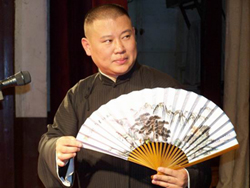| Tools: Save | Print | E-mail | Most Read |
| The Return of Traditional Crosstalk |
| Adjust font size: |
The traditional performance art of crosstalk is making a comeback with the help of crosstalk specialist, Guo Degang. He performed at the PLA Opera House on January 11 and 12, 2006. Although the performance wasn't formally advertised, many turned up and jammed the box office trying to get tickets. Tickets were sold for 20 yuan (US$2.4), but had a black market value of as much as 300 yuan (US$36). Response was so good that the theater decided to add another performance on January 25. Guo doesn't belong to an official group or troupe, and has never performed on TV. But attending his crosstalk performance is becoming increasingly trendy in Beijing, especially for young executives and school children who load their MP3 players with his works. He might not be mainstream, but Guo was able to command 25 encores on January 11, adding some three hours to the originally scheduled two-hour performance. Traditional crosstalk
The performers will try their best to make fun or take advantage of the other/s with the skillful play of words, a technique that brings to the fore the craft and wit of the Chinese language. In the old days in Tianjin, Beijing, and elsewhere, temple fairs and street markets were where crosstalkers performed. More famous performers were invited to perform in teahouses and theaters. Guo said that, in those days, "the average crosstalker could earn more than the total earnings of ten rickshaw pullers". Crosstalk pieces draw on every aspect of Chinese culture, from history and folk tales to contemporary social issues. Although there are hundreds of pieces in the traditional repertoire, they are usually edited to suit the times and the audience.
During the Cultural Revolution (1966-76), the art was criticized as decadent and belonging to the old society. Lots of crosstalk works were lost during this time. Crosstalk has also seen a dramatic decline in recent years with fewer scripts and performers. Few live shows are performed at theaters, and only the really famous performers are invited to do their thing on TV. Even then, it's usually only once a year during the Spring Festival Gala. Their dilemma is the same as that faced by other practitioners of traditional Chinese folk art; in a rapidly developing society where people have more and more entertainment choices, traditional art forms are increasingly unattractive. Guo arrived in Beijing from Tianjin in 1995 to embark on his crosstalk career, only to find that the art form was on the decline. The rejuvenation of crosstalk
Being a crosstalker himself, he couldn't resist taking to the stage. Gradually, more and more people came to the teahouse to see him perform. He soon found himself playing to audiences numbering more than 100 in a teahouse that could only accommodate 80. As his popularity grew, Guo pondered the future of his art. "Traditional crosstalk is at least half an hour long, but performances are no longer than five minutes on TV, which kills much of the story. TV is part of the fast-food culture and crosstalk is a face-to-face art form -- it needs interaction, and is not suited to TV," Guo said. He was determined to bring it back to its roots, the teahouse and theater. In 1996, Guo and some young crosstalk actors founded Deyun Crosstalk Association aimed at returning crosstalk to teahouses and theaters. Over the next ten years, the association organized countless performances in teahouses across Beijing. Despite their growing popularity, Guo ensured that ticket prices were kept low to make the art form accessible to everyone. Tickets to his performances are still 20 yuan today. Guo said that training to be a crosstalk actor requires an inordinate amount of hard work. In the old days, children who wanted to learn crosstalk had to live in the crosstalk master's home. Only after seven or eight years of rigorous training were the more talented ones allowed to perform with their masters on stage. It would take about another sixteen years before young actors forged styles of their own. Guo added that a crosstalk actor didn't usually find fame and fortune until well into his 40s. To preserve the art form, the association has recorded more than 600 traditional crosstalk pieces, while the Complete Collection of Chinese Crosstalk recorded by all famous crosstalk masters, from the fourth to the eighth generations, only contains 400 pieces.
Guo hopes that this means a revival for the dying art form, and that through the association's efforts, more young people will learn to appreciate it and perhaps train to be crosstalkers themselves. (China.org.cn by Chen Lin, February 3, 2006) |
| Tools: Save | Print | E-mail | Most Read |
 |
| Related Stories |
|
| Product Directory China Search |
Country Search Hot Buys |



